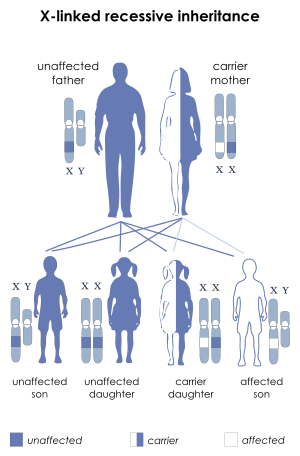Mohr–Tranebjærg syndrome
Mohr–Tranebjærg syndrome (MTS) is a rare X-linked recessive syndrome also known as deafness–dystonia syndrome and caused by mutation in the TIMM8A gene. The severity of the symptoms may vary, but they progress usually to severe deafness and dystonia and sometimes are accompanied by cortical deterioration of vision and mental deterioration.
| Mohr–Tranebjærg syndrome | |
|---|---|
| Other names | Deafness–dystonia–optic neuronopathy syndrome, Deafness–dystonia–optic atrophy syndrome, Deafness syndrome, progressive, with blindness, dystonia, fractures, and mental deficiency |
 | |
| Mohr–Tranebjærg syndrome is inherited in an X-linked recessive manner | |
Genetics
This condition is caused by mutations in the TIMM8A gene. This gene is located on the long arm of X chromosome (Xq22).
The protein encoded by this gene localizes to the intermembrane space in mitochondria where it functions in the import of nuclear encoded proteins into the mitochondrial inner membrane. How this produces the clinical picture is not yet clear.
Clinical
The usual presentation is of early childhood onset hearing loss.
This is followed by adolescent onset progressive dystonia or ataxia, visual impairment in early adulthood and early onset of dementia. The onset of dystonia is accompanied by brisk tendon reflexes, ankle clonus and extensor plantar responses.
Loss of vision, photophobia, acquired color vision defect and central scotomas usually occur about 20 years of age. By the age of 30 to 40 many are legally blind.
This visual loss is normally accompanied by a slowly progressive dementia.
Diagnosis
This is made by sequencing the TIMM8A gene.
Differential diagnosis
This is long and includes
- Arts syndrome
- Autosomal recessive nonsyndromic sensorineural deafness type DFNB
- Friedreich ataxia
- MELAS syndrome
- Mitochondrial DNA depletion syndrome (encephalomyopathic form with methylmalonic aciduria)
- McLeod neuroacanthocytosis syndrome
- Pendred syndrome
- Usher syndrome type 1 and 2
- Wolfram syndrome
- X-linked spinocerebellar ataxia type 3 and 4
Treatment
Cocheal implants are of dubious value in this condition. Hearing aids are of use. Treatment is supportive.
History
This condition was first described in 1960.[1]
References
- Mohr J, Mageroy K (1960). "Sex-linked deafness of a possibly new type". Acta Genet Stat Med. 10: 54–62. PMID 13771732.
External links
| Classification | |
|---|---|
| External resources |
- GeneReviews/NCBI/NIH/UW entry on Deafness–Dystonia–Optic Neuronopathy Syndrome
- MTS — a page at NIH website